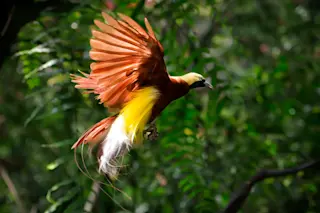“There is the severest rivalry between the males of many species to attract,” said Charles Darwin in the 1850s. But nowhere is this rivalry as brilliant and bizarre as it is among the tropical birds-of-paradise. “Males display their gorgeous plumage and perform strange antics before the females,” Darwin stated of the birds, “which, standing by as spectators, choose the most attractive partner.”
Indeed, the odd beauty and outlandish behavior of male birds-of-paradise are so strange that they sometimes feel impossible to fathom. But ornithologists say that there's a whole lot to learn about these birds, and about their mating practices in particular. So, with that in mind, this is what we know about the birds-of-paradise and their complex process of courtship.
Paradisaeidae
Commonly called the birds-of-paradise, the Paradisaeidae are a family of birds famous for their bizarre beauty. Tracing their ancestry to a tropical crow-like creature that lived approximately 24 million years ago, the birds within this family spent many millennia developing their own distinctive traits.
Where Do Birds-of-Paradise Live?
Found in the tropical and mountain forests of a small swath of Australia, New Guinea and a few nearby islands, the birds-of-paradise roam in a relatively small range. There, they fly through the trees and flutter across the forest floor, where they forage for fruit and search for suitable partners with whom to mate.
Read More: In the Bird World, It Takes Big Brains or Big Guts to Survive in Extremes
The Types of Birds-of-Paradise
All told, there are around 45 separate species within the family, which fall into 17 separate genera. Characterized by common characteristics and shared ancestry, some of these genera contain several species of bird (such as the Paradisaea genus), while others comprise a single species of bird (such as the Seleucidis genus).
Some of the best-known species within the family come from the Paradisaea grouping, though they aren't the only type of bird in the bird-of-paradise taxon. Others include the “sicklebills,” “sickletails,” riflebirds and paradise-crows, among an assortment of other fabulously feathered creatures.
What Do Birds-of-Paradise Look Like?
Whether the size of a starling or the size of a crow, the birds-of-paradise tend to possess prolonged beaks and plump bodies. Beyond that, the birds within the family vary in terms of their appearance.
In fact, even the members within a specific species of bird-of-paradise can look dramatically different from each other, all thanks to the process of sexual selection.
Female Birds-of-Paradise vs. Male
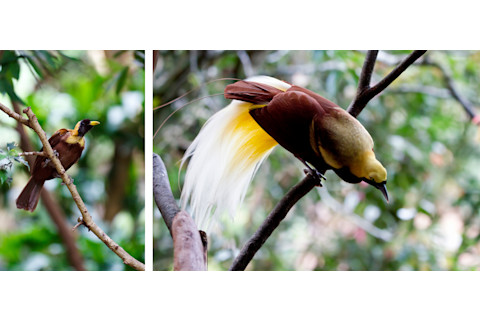
Female and Male Paradisaea Rubra (Credit: Elliotte Rusty Harold/Shutterstock and Kurit Afshen/Shutterstock).
Elliotte Rusty Harold/Shutterstock and Kurit Afshen/Shutterstock
Sexual selection is a type of natural selection in which individuals of one sex pick mates of the opposing sex that possess particular "attractive" traits. Among the birds-of-paradise, females pick males, influencing male appearances and actions gradually through the generations.
For instance, while female birds-of-paradise tend to have dark, drab feathers to blend in with their surroundings, male birds-of-paradise tend to have brilliant, bright feathers to make themselves more attractive to females. And this is only one of many traits that male birds-of-paradise possess to find female admirers.
The Complicated Courtship of Paradisaeidae
Put simply, male birds–of–paradise are made to attract. Armed with an assortment of alluring tools, from flashy feathers to dazzling dances, these birds are perfectly tuned to the preferences of their female counterparts.
Read More: Climate Change Could Be Making Birds Smaller
Courting with Color
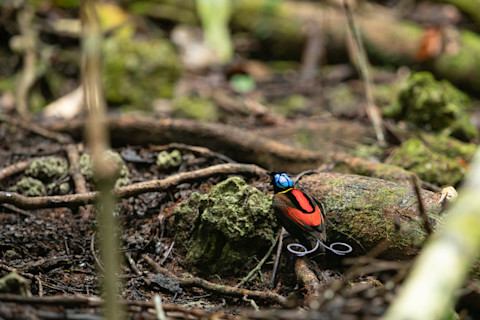
Cicinnurus Respublica (Credit: 5213P/Shutterstock)
5213P/Shutterstock
Male birds–of–paradise come in an assortment of shades. And some come in several shades at once, as with the Wilson’s bird-of-paradise (Cicinnurus respublica). Splashed across their feathers, feet and beaks, the colors of these birds can be lustrous, lusterless or even iridescent, transforming from the amount of light that bounces off a bird's body.
The riflebirds — a group that includes the magnificent riflebird (Ptiloris magnificus), the paradise riflebird (Ptiloris paradiseus), and the Victoria's riflebird (Ptiloris victoriae) — all share a splash of blue-green iridescence across their breasts. Shifting their bodies to show off their shine, male riflebirds make strategic use of their iridescence to attract female mates and outshine male competitors.
Flirting with Feathers
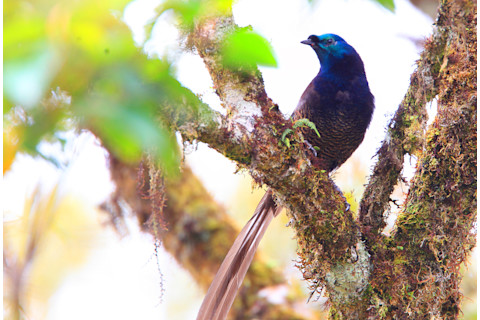
Astrapia Mayeri (Credit: feathercollector/Shutterstock)
feathercollector/Shutterstock
The beauty of male birds–of–paradise doesn’t stop at shade. It also involves plumage. Evolving their feathers over the course of millions and millions of years, these birds have highly specialized fluff, which springs from their faces, torsos and tails.
These feathers function only to attract female attention. Take, for instance, the three-foot tails of the ribbon–tailed astrapia (Astrapia mayeri). Though these feathers can catch in the treetops, they allow male astrapia to find female companions.
While some male birds–of–paradise call attention to their feathers by ruffling them out or fluttering them to and fro, others transform their appearance by arranging their fringe in particular positions. Using the feathers on their wings and tails, magnificent riflebirds are just one of many birds–of–paradise that turn themselves into a strange oval shape.
Bird Mating Songs
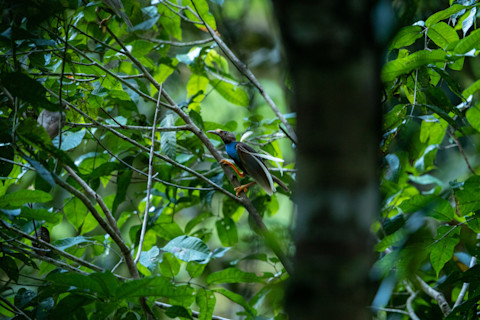
Semioptera Wallacii (Credit: 5213P/Shutterstock)
5213P/Shutterstock
Adding to the attractiveness of male birds–of–paradise is their song. Male riflebirds let out loud whoops to convince female riflebirds to come closer. And to add to these whoops, they also make non-vocal sounds as a form of flirtation. Producing a powerful "woosh” when they throw open their wings, some ornithologists suspect that the movement of the male riflebird is intended to amplify sound.
And other birds–of–paradise make their own sounds, from the screeches of the standardwing (Semioptera wallacii) to the whistles of the black-billed sicklebill (Drepanornis albertisi).
Bird Mating Dances

Ptiloris Victoriae (Credit: Dirk Kotze/Shutterstock)
Dirk Kotze/Shutterstock
Any male bird-of-paradise worth its feathers boasts a brilliant voice and bright, beautiful plumage. (And these traits take time to develop, with some species taking as many as four to seven years to reach their full, feathered form.) But their true trick to finding a partner is dance.
Far from improvisation, the birds perform a surprisingly specific set of movements that shows off their most attractive features. The Victoria’s riflebird curves its wings above its body and tosses its head from side to side, showing off its blue-green breast. Meanwhile, the western parotia (Parostia sefilata) flutters, flaps and shakes.
Bird-of-Paradise Mating
When males finish their dramatic displays, and when females decide that they’re willing to mate, the birds are already approaching the final moments of their fling. In fact, most male birds-of-paradise take off immediately after mating, fully abstaining from the parenting process.
Though the typical clutch size shifts according to species, smaller birds-of-paradise tend to lay two to three eggs at a time and larger birds-of-paradise tend to lay one. Eggs usually hatch after around 16 to 22 days, and hatchlings usually fly after around 20 to 30. And although the average female takes around a year to mature, the average male takes much more time to prepare for future forays into mating and courtship.
Much of what we know about the birds-of-paradise comes from The Cornell Lab's Birds-of-Paradise Project. Between 2004 and 2012, the team behind the project took still images and videos of each and every species within the Paradisaeidae family that was then known to ornithologists. Learn more about the project at https://www.birdsofparadiseproject.org.
Read More: Current Extinction Could Cause Birds to Become Less Unique



